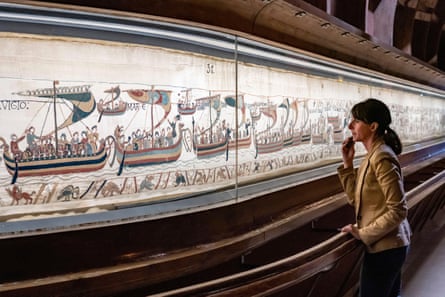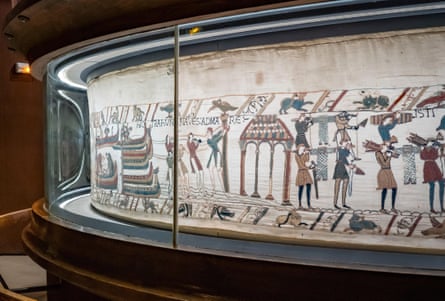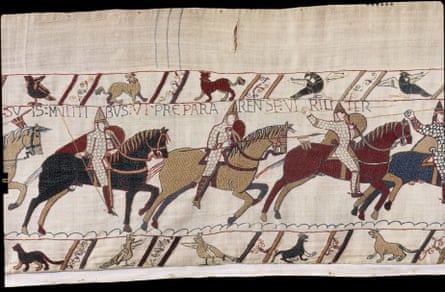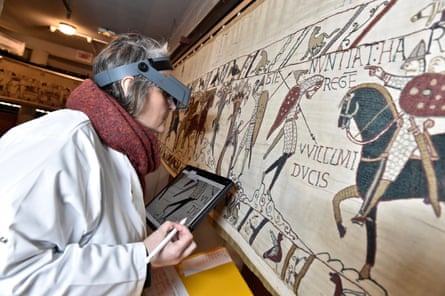The Bayeux tapestry is so fragile that transporting it risks irreparable damage, French experts have said, as a petition urging Emmanuel Macron to reverse a “catastrophic” decision to loan the unique embroidery to Britain passed 60,000 signatures.
France’s president declared in July that the nearly 1,000-year-old, 70-metre-long wool-on-linen artwork, which depicts William the Conqueror’s victory over King Harold II of England at Hastings in 1066, would cross the Channel next year.
For nine months from September 2026, it is due to be on display at the British Museum, whose director, Nicholas Cullinan, has called it “one of the most important and unique cultural artefacts in the world”, symbolic of a millennium of shared history between Britain and France.
French conservators who have worked on the embroidery, however, say it is so fragile as to be essentially untransportable, and the organiser of a campaign against the loan argues Macron has ignored near-unanimous expert advice for a grand political gesture.

“I’m not against the loan of cultural artefacts and I have always liked the UK,” said Didier Rykner, the editorial director of La Tribune de l’Art, an art news website, whose month-old petition against the loan has been signed by nearly 62,000 people.
“But this is a purely political decision. Here is an extraordinary work of art, a wholly unique historical document, an artefact without equivalent anywhere – and which expert opinion agrees, overwhelmingly, cannot travel. It’s not complicated.”
Macron first suggested lending the Bayeux tapestry to the UK – as previously requested by London, and rejected by Paris, for the coronation of Elizabeth II in 1953 and, in 1966, for the 900th anniversary of the Battle of Hastings – in 2018.
Conceived as the sort of momentous cultural offer that might help sustain British ties to the continent even as it was preparing to quit the EU, the plan foundered as cross-Channel relations soured during the bitter Brexit negotiations and their aftermath.
The idea was resurrected as relations gradually improved after Boris Johnson and Liz Truss left Downing St, and accelerated with Keir Starmer’s EU “reset”. French officials say King Charles was also instrumental and personally “very supportive” of the plan.
But the loan agreement to celebrate cross-Channel reconciliation – which will also involve French museums displaying artefacts from the Anglo-Saxon burial site Sutton Hoo, and the Lewis Chessmen – ignores decades of warnings about the state of the tapestry.

Housed since 1983 in a purpose-built museum in Bayeux due to close next month for a major two-year renovation, the fabric has been severely weakened by age but also, experts say, by being displayed suspended from a rail, rather than laid out flat.
Some of the most damning arguments against the plan have come from curators and restorers who have worked or are working on the tapestry, five of whom have told Rykner – on condition of anonymity – of their disbelief and concern.
Precisely because the tapestry was considered too fragile to move far, complex plans were already under way to remove it from display and store it during the museum’s rebuilding work, with a full restoration to follow once it was returned.
“We fell off our chairs when we heard,” said one conservator. “It’s the opposite of all we had prepared for.”
Any movement at all of the canvas, in a state of “absolute fragility”, was “fraught with risk, an incredibly delicate operation”, said another.
Now the embroidery is set to be carried over a distance of possibly more than 500km (310 miles) “in its most fragile state, with its stabilising lining already removed, and before its restoration”, said a third.
after newsletter promotion

All emphasised that the thousands of existing weak spots would be strained, with every movement risking tears, and it seemed almost impossible that what would have to be an entirely new system of transporting the tapestry could be designed in time.
“It’s discrediting our profession,” one said. “Not listening to us is like saying we’re useless.” A rare conservator to speak publicly, Thalia Bajon Bouzid, said any damage would be irreversible: “Tears would not be repaired, for reasons of authenticity.”
The curators’ fears echo multiple previous expert warnings. As early as 2018, Antoine Verney, the chief curator at the Bayeux Museum, said he “could not conceive” of it being moved far.
A report by eight antique textile experts in 2020 recommended a full restoration, identifying 24,204 stains, 16,445 creases, 9,646 deficiencies and 30 “non-stabilised” tears, and a pre-restoration study in 2021 “advised strongly against transporting the tapestry over a long distance (for more than an hour)”.
That study added: “The longer the timeframe for micro-alterations to occur, the greater the risk that visible and irreversible alterations will appear”, especially since “no vibration-absorption system currently exists that can eliminate all risk during transportation”.

Yet another analysis the following year reached much the same conclusion, according to Le Monde – but remains confidential except to companies submitting tenders for a full feasibility study into the tapestry’s proposed removal to London, Rykner said.
So far, the French government has barely acknowledged the experts’ concerns. Macron went out of his way to dismiss them, saying in July that France had “found the best experts of the world to explain in perfect detail” why the loan “was impossible”, but “we decided” otherwise.
Philippe Bélaval, the president’s special adviser on the project, has insisted the tapestry is “absolutely not untransportable”, referring to an “extremely precise” – but confidential – report from early this year detailing what precautions must be taken.
“Playing with words,” said Rykner. “The transport had already been decided, so it was not the job of this report – about which we know strictly nothing – to argue against it. Any artwork is transportable. The question is, in what condition will it arrive?”
The fact of the matter, Rykner said, was that Macron, famously enamoured of both the grand theatrical gesture and making his own decisions, had placed politics over the conservation of an exceptionally vulnerable piece of cultural heritage.
One of the tender documents related to the loan, Rykner said, contained what was probably a mistake, but a revealing one: “The loan of the Bayeux tapestry has been granted”, it reads, “by the President of the Republic, owner of the work …”
In the 17th century, Louis XIV, the Sun King, apocryphally said: ‘“L’état, c’est moi” (“I am the state.”) This, Rykner said, was a case of “‘La tapisserie, c’est moi.’ It’s outrageous, and people are starting to see why it must be stopped.”

 3 months ago
49
3 months ago
49

















































